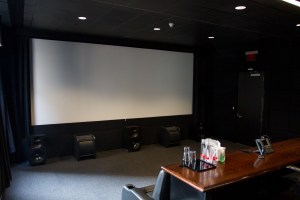Hollywood Moves East: Tax Incentives, Growing Tech Talent Pool, Beckoning Film Industry
By Billy Gray February 19, 2013 9:00 am
reprintsTo moviegoers, the intersection of New York real estate and film exists as a loop of timeless screen images. Audrey Hepburn gazes into the Tiffany window. Woody Allen and Diane Keaton sit in the shadow of the 59th Street Bridge. Meg Ryan feigns an orgasm at Katz’s.
Whether their scenes were filmed in the city or recreated on a Burbank soundstage, filmmakers have always relied on New York for the dramatic backdrops that its skyline, landmarks, restaurants, avenues and enviable apartment interiors provide.
But 80-odd years after the entertainment industry decamped for Los Angeles—its persistent warmth and sunshine conducive to long shoots, its sprawl hospitable to mammoth studio lots—an increasing number of Hollywood pros are leaving their temperate backyards and making New York their backlot once again with a handful of transactions for actual brick-and-mortar office spaces across Manhattan.
“I moved to New York eight years ago because of the level of work that was happening here,” said Eric Robertson, the visual effects supervisor at the digital studio Mr. X, which expanded from Toronto to Manhattan last year. “That and the fact that a lot of filmmakers were coming home from L.A. People just want to live here because it’s such a hotbed of creativity. And everyone loves New York.”
Of course, the film and television industry never left the city. John Cassavetes, Martin Scorsese, Woody Allen, Spike Lee and Darren Aronofsky are just a few homegrown cinematic bards who preferred to stay put. New York University’s Maurice Kanbar Institute of Film and Television famously churns out indie darlings. And quintessential New York TV series like Law & Order and Sex and the City were produced locally to gritty and glossy effect—even if Seinfeld was shot in Studio City.
But over the past decade, cultural, economic and political forces have coalesced to bolster New York’s reputation as Hollywood East.

“We’re seeing a reverse migration,” said Yana Collins Lehman, an executive board member of the Post New York Alliance, which oversees and lobbies on behalf of a number of postproduction facilities and labor unions. “What flummoxed us in the past was that we’d educate the kids here, but then there wouldn’t be jobs. Now, talent that left New York is coming back.”
New York’s unyielding status as a creative hub and educational powerhouse reels in everyone from directors to screenwriters to grips. But in recent years, the city’s growing stature as an entertainment hub has stemmed in part from considerably less-cinematic Albany.
The New York State Film Production tax credit program was enacted in 2004 and now offers a 30 percent credit for eligible expenses, allocating a total of $420 million per year to the film and TV industries. A 10 percent credit specific to postproduction—the first of its kind in the country—followed in August of 2010.
Last July, Gov. Andrew Cuomo raised the postproduction incentive to 30 percent of qualifying costs, calling it an invitation for productions to “come to the Empire State, the future television and film capital of the world.” (The postproduction credit applies to projects that were filmed outside of New York.)
“We went up to Albany in 2010 and were really idealistic and excited about this credit, and we asked for 10 percent and we got it,” Ms. Lehman said. “It was the only legislative add that year. The budget was really late. But we were psyched. Then we very quickly realized that 10 percent was not going to do the trick.”
In the two years between its original passage and its tripling in size, 18 projects applied for the postproduction credit. In the past six months, 34 have applied. And while only $7 million of the production program’s $420 million is carved out for post-shoot work, the process it supports—editing, sound-mixing and -designing, special effects wizardry—is lengthier than production (36 to 52 weeks versus eight to 10 weeks, according to postproduction workers).
Unlike the $4 million indie film crew that shoots on the streets for a month, a postproduction team’s time frame and heavy duty technological machinery require roots. Mr. Robertson, the president of the recently hatched Mr. X Gotham, searched for permanent offices last year.
“We really wanted to be in the production central area,” he said. “We wanted to walk to the other post houses—Technicolor, Deluxe, PostWorks and Post Factory,” which congregate along Avenue of the Americas, Greenwich Street and the intersection of Leroy and Hudson Streets.
Mr. X landed in 4,000 square feet at 214 Sullivan Street in the Village, a boom mic’s throw away from N.Y.U. “Interestingly, from the very first day, the brokers said they had options in our price range and the size we wanted,” Mr. Robertson said. “It was funny looking at the commercial market being so different than residential, where you feel desperate from Day 1. It was really a very pleasant experience. It felt like everything was a gift being given to us.”



